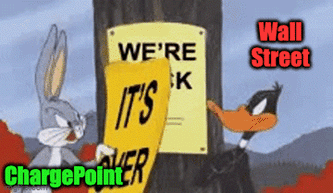
So Give Me Coffee & EVs
Easily…
I’ve seen so much electric vehicle (EV) news, I’m going blind, and I’m brain-dead virtually. Investing? It’s hard enough already…
Chop chop, Great Stuff. It’s too late in the week for riddles.
Hasty today, aren’t we? Gee… In your rush, you might’ve also missed the massive deluge of EV news this morning. A Blur, if you will.
Longtime Great Ones … you know what this means? Great Stuff’s longest-running soap opera, EV Days, just got renewed for a new season!
Oh. Yay, I guess…
Hey, why should Wall Street’s theatrics be limited to the oil market? Just check out the neck-and-neck race that’s erupting out in the EV-making arena!
OK, maybe the race between the likes of Tesla (Nasdaq: TSLA), Ford (NYSE: F) and General Motors (NYSE: GM) isn’t that neck and neck … but it is dramatic. This is EV Days, after all. What’s an electrified soap opera without bravado and one-upmanship? The Musk-y memes?
To Tesla, worldwide EV domination is (always) just a few new gigafactories away. And this week, German newspapers reported that Tesla’s new Berlin-based plant just received final environmental approval.
After two years of construction — and much hubbub about deforestation/water supply concerns — oh, you better believe Tesla investors are getting the celebratory currywurst ready!
Remember, this factory is supposed to have one of Tesla’s fancy shmancy “giga presses,” which can stamp out a Tesla chassis in one or two pieces, compared to the usual hodgepodge of stamping and welding that goes into making a car body.
Plus, the European foothold would let Tesla cut down on transit costs from shipping cars out of America and China.
Ooh, ahh. We’re all very impressed down here.
Except … there’s a catch … a holdup in Tesla’s giddyap:
That doesn’t sound much like “final approval” after all, does it? What gives?
Right now, it’s unclear how much more evidence Tesla will have to cough up before its Berlin factory is a fully operational battle station. Though, Tesla needs new production from its German and Austin plants to build the 1.5 million EVs that Wall Street’s targeting for this year.

TSLA investors didn’t quite like that news and sent the stock down 3% today. As you know, where there’s Tesla, there’s a dozen other automakers tryin’ to be Tesla … or at least catch up to the Big Red T.
And Ford? Oh, Ford wants to be like Tesla so, so bad — to join Tesla in those green, EV-making pastures. But Ford’s still working through its own identity issues, trying to move on from depending on its slick, filthy ex — oil.
Just yesterday, we talked up Ford’s attempts to signal that it’s ready to mingle with the real EV makers, dividing its business up into separate gas-powered and electric segments.
This isn’t the complete EV spinoff that many analysts still expect, and it’s awfully reminiscent of GM’s own gas/electric engineering division from 2019. But it’s a start for Ford’s EV future. I guess…
For its part, Ford plans to dump cash into its new Ford Model e EV business — catchy name, I know — in a desperate attempt to out-Tesla Tesla’s global gallivanting. Notably, this includes cold-shouldering its own European production to focus on EVs, but hey, let’s just kick that can down the road for now…
Despite having one foot in the EV race and the other on a gas-powered banana peel, CEO Jim Farley is ready to go “all in, creating separate but complementary businesses that give [Ford] start-up speed and unbridled innovation in Ford Model e…”
Why, aren’t we just a regular ol’ Lee Iacocca over here? Ford’s doubling EV spending this year to $5 billion, with plans to inject a whole $50 billion into its EV biz by 2026. Of course, by then, Ford will be building up to 2 million EVs a year!

That is, if you believe the company’s lofty projections. And considering this is the third time this year that Ford has one-upped its own spending projections, Wall Street’s getting a bit tired of the automaker who cried EV.
Morgan Stanley expects Ford will only make 560,000 EVs by the time 2026 rolls around. The big banking bro also joined Deutsche Bank in blasting Ford’s 10% operating profit margin target as “ambitious” at best, even with Ford juicing up its EV production by billions of dollars.
Still, all that doubt ain’t gonna stop Ford from investing in the future of EVs … and neither should it stop you. (The confidence is just so inspiring, guys, I tell you what.)
So after this rambling episode of EV Days, we have Ford expecting the world from its future self, while analysts doubt almost every part of Ford’s hopeful dreams. I mean, it is Ford, after all.
Tesla’s European adventure remains stuck in environmental red tape over in Germany, and Wall Street’s holding steady on its ever-lofty production expectations.
And GM? Ha, GM is only now walking away from its Lordstown disaster with its tail between its legs.
With the dons of Detroit duking it out and Tesla just being Tesla … it’s time to pull a Fleetwood Mac and go your own way.
Editor’s Note: But Before You Leave For Greener EV Pastures…
We’ve told you before that the No. 1 problem preventing the mass adoption of EVs is cost. But for EVs, the tipping point — affordability — may finally be arriving, thanks to a brand-new battery technology.
This stunning new technology is about to cut the cost of EV batteries IN HALF … meaning by next year, an EV is expected to cost the same as a gas-powered car.
To discover the company behind this new technology, click here now.
Another Bookstore Bites The Dust

Are you hanging on the edge of your seat, Great Ones? You should be … because Amazon (Nasdaq: AMZN) just announced that it’s closing dozens of those novelty bookstores it opened up for no reason other than nostalgia’s sake.
Well … that and making some quick cash off travelers lost in layover purgatory.
I mean, where have you ever seen one of these pop-up Amazon bookstores other than an airport? (Seriously … if you’ve seen one of these shops out in the wild, let me know where Amazon’s been hiding them.)
In my humble opinion, Amazon’s expansion into the brick-and-mortar industry was kitschy at best … and downright dumb at worst. You don’t ring the retail death knell for brick-and-mortar bookshops and then turn around and open your own physical pop-up locations. That’s just silly.
Amazon is the king of online retail for a reason: It offers everything that anyone would ever want or need when shopping online, from the comfort of their own homes — books included.
Like, how often do you browse for something on Amazon and then go out searching for it in one of your local shops? My guess is “next to never.” If that were the case, big-box stores like Best Buy (NYSE: BBY) would probably deliver better earnings (more on that in a minute).
Given the fact that Amazon stock barely budged on news of its coming closures, I have to think AMZN investors weren’t all that surprised by the company’s book-burning bonanza.
Metaphorically speaking, of course. Burning books is bad … very, very bad.

We’ve only held EV charging station company ChargePoint (NYSE: CHPT) in the Great Stuff Picks portfolio for two short months.
But based on its recent earnings report, ChargePoint’s “Charging as a Service” (CaaS) packages are already starting to pay off.
In case you missed our ChargePoint talking points earlier in the year, you can read up on everything the company’s doing to revolutionize the EV industry right here.
Upon stepping into the earnings confessional, the only sin ChargePoint had to account for was delivering an earnings loss of $0.17 per share (a penny above Wall Street’s consensus). On the bright side, it brought in better-than-expected sales of $80.7 million — which was on the high end of the company’s own guidance.
According to CEO Pasquale Romano, that’s not the only thing for investors to get amped about:
That said, as we told you back in January, investing in ChargePoint needs to be done with caution. The reason being that investors are less likely to sink money into smaller-cap companies during times of turbulence and higher inflation … two things we’ve had in spades since the start of 2022.
All things considered, CHPT is trading at a fantastic discount to the company’s growth potential — even more so than when we recommended it on January 6. (I know, I know. This sounds like a convenient way to gloss over the fact that ChargePoint’s down … but we did warn you of this inherent volatility.)
If you’re a risk-taker and see the same CaaS potential that we do, CHPT is still a solid buy. Just know that Russia’s invasion of the Ukraine could hamper your short-term returns as Wall Street digests this latest disaster.
And remember … the conflict going on between Russia and Ukraine just validates the need for alternative energy solutions. We covered this in detail yesterday, so I won’t harp on it here.
What I will say is that alternative energy adoption is already on the rise — and about to experience a huge boost thanks to one tiny Silicon Valley firm’s recent discovery.
This company is using AI tech to crack open the largest untapped energy source on the planet, making it available at scale for the entire globe.
To find out more about this company, click here.

Wall Street added Kroger (NYSE: KR) to its shopping list this morning after the grocery store giant announced growing sales and profits in its latest quarter.
Adjusted earnings per share came fully stocked at $0.91 on sales of $33.05 billion — blowing away Wall Street’s earlier estimate for earnings of $0.74 per share on sales of $30.74 billion. Identical sales were also up 15% compared to two years ago, before the COVID-19 pandemic spread like a pox across the land.
By Kroger’s calculations, people started preparing more meals at home during the pandemic, a trend that’s continued to gain traction even as travel and restaurant-related restrictions ease.
It’s almost like everyone collectively woke up from their pre-packaged and restaurant-reliant food comas and realized they could save a ton of money by switching to grocery stores. Ah yes, the home-cooked meal … I remember you.
So long as people continue to make the money-saving switch from takeout to dining in — like, real dining in and not just Hot Pockets like someone on the Great Stuff team — Kroger should continue to kill it (supply chain issues willing).
While I don’t see an expiration date on Kroger shares, my advice to you is this: Do not shop for KR stock on an empty stomach.
Otherwise, you may wind up with way more of the stock than you initially bargained for…

It was the best of buys … it was the worst of buys … but more evidence pointed toward the latter after reading Best Buy’s latest earnings report.
Same-store sales at the electronics retailer dipped a depressing 2.3% during the quarter despite it being peak holiday shopping season, underperforming both Wall Street and Best Buy’s own expectations.
Net income also dropped to $626 million (or $2.62 per share) from $816 million (or $3.10 per share) from the year prior.
But don’t you worry, Best Buy investors. CEO Corie Barry says: “We do not for one minute believe we hit our peak revenue and margin this past year.” Well, isn’t that nice.
The thing about Best Buy is that it provides customers with an excellent window-shopping experience for items they can then buy elsewhere (ahem, Amazon) for a far better price … assuming Best Buy actually has items in stock for you to look at in the first place.
Though speaking from personal experience, I’ve been burned far too many times by Best Buy’s in-store merchandise tracker to believe anything it tells me…
Of course, management blamed the usual suspects for its seasonal earnings miss, citing supply chain issues, inflation and chip shortages as the bug in Best Buy’s CPU.
But rather than leaving BBY investors with empty shopping carts, Best Buy did deliver a 26% quarterly dividend increase, as well as a $1.5 billion share buyback announcement. If not for these table scraps, BBY stock surely would’ve been in the red today rather than climbing 8%.
As always, GreatStuffToday@BanyanHill.com is your home for hot takes and spit takes, investing questions and random market tomfoolery too. Whatever you want to write, we want to read!
In the meantime, here’s where you can find our other junk — erm, I mean where you can check out some more Greatness:
- Get Stuff: Subscribe to Great Stuff right here!
- Our Socials: Facebook, Twitter and Instagram.
- Where We Live: GreatStuffToday.com.
- Our Inbox: GreatStuffToday@BanyanHill.com.
Until next time, stay Great!










